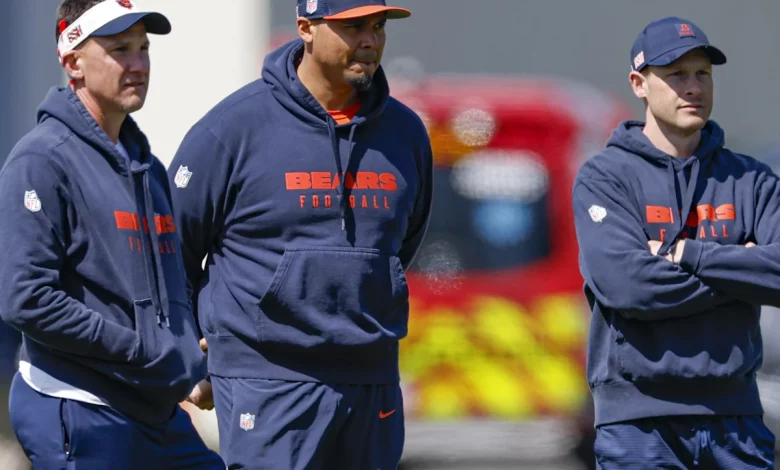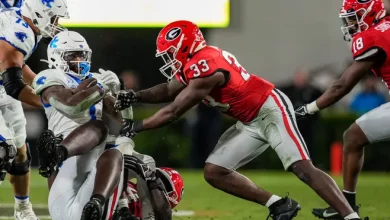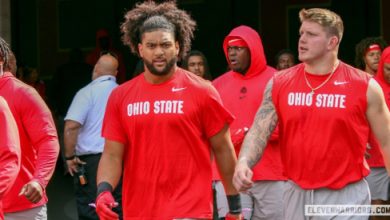Dennis Allen aims to improve Bears defense with aggressive pass rush, disciplined coverage, and versatile schemes, focusing on consistency, leadership, and strategic flexibility.

The Chicago Bears have long been searching for a cohesive, dominant defensive identity—a unit that can consistently disrupt opposing offenses, force turnovers, and elevate the overall team performance. With the hiring of Dennis Allen as defensive coordinator, and his subsequent influence on the team’s defensive philosophy, there’s renewed optimism that the Bears are heading in the right direction. Allen’s plan revolves around three core principles: establishing an aggressive pass rush, implementing disciplined coverage, and deploying versatile schemes that adapt to various offensive threats.
Understanding these pillars offers insight into how the Bears aim to rebuild their defensive identity, improve their standings in the NFC, and establish a foundation for sustained success. Let’s explore each of these strategic elements in depth, analyzing their significance, implementation, and the challenges involved.
1. An Aggressive Pass Rush: Disrupting Opponents at the Line
The Importance of the Pass Rush
In modern NFL defenses, the pass rush is often considered the backbone of success. A relentless, disciplined rush can collapse pockets, force hurried throws, and generate turnovers. Teams like the Philadelphia Eagles and San Francisco 49ers exemplify how a potent pass rush can elevate a defense from average to elite.
For the Bears, improving the pass rush has been a priority. Historically, their pass-rushing production has been inconsistent, often relying heavily on a few players or lacking pressure on quarterbacks altogether. The addition of key players, combined with Allen’s strategic emphasis, aims to change that.
Allen’s Philosophy on Pass Rush
Dennis Allen is known for his aggressive approach—encouraging his defensive linemen and linebackers to attack the line of scrimmage with relentless energy. His schemes often prioritize creating mismatches and exploiting offensive line weaknesses through varied stunts, blitzes, and creative alignments.
He emphasizes the importance of disciplined aggression: players must attack with purpose but maintain gap integrity to prevent big plays. Under Allen, the pass rush isn’t just about individual talent but about coordinated team efforts that keep offenses guessing.
Implementing the Strategy
- Player Development and Acquisition:
The Bears have invested in pass-rushing talent, notably drafting or signing players capable of applying pressure. Young pass rushers like Trevis Gipson and first-round pick (if applicable) are expected to develop under Allen’s tutelage. Veteran presence, such as Robert Quinn (if still on the roster) or new acquisitions, provides leadership and stability. - Scheme Variations:
Allen often employs multiple fronts—3-4, 4-3, or hybrid schemes—to keep offenses off-balance. By varying the look and blitz packages, he aims to create confusion and open lanes for pass rushers. - Maximizing Player Strengths:
Scheme design under Allen focuses on leveraging players’ unique skills. For example, faster edge rushers are used to contain the outside, while interior linemen might be tasked with collapsing the pocket from the middle.
Challenges and Opportunities
- Consistency:
Developing a relentless pass rush requires continuous effort. Inconsistencies in technique, effort, or injuries can hamper production. - Balancing Pressure and Coverage:
Aggressiveness must be balanced against coverage discipline. Overly aggressive blitzes can leave vulnerabilities for big plays if not executed properly. - Injury Risks:
High-motor players pushing the limits might be prone to injuries, which could impact the overall pass rush.
Expected Outcomes
If Allen’s aggressive approach bears fruit, the Bears’ defense could see a significant uptick in sacks, quarterback pressures, and turnovers. This aggressive pass rush could also set the tone for the entire defense, energizing the team and intimidating opponents.
2. Disciplined Coverage: Reducing Big Plays and Forcing Mistakes
The Role of Coverage in Defensive Success
While pass rush disrupts the quarterback, disciplined coverage prevents receivers from getting open, creating a complete defensive picture. A disciplined secondary minimizes big plays, forces quarterbacks to hold the ball longer, and increases the likelihood of sacks and turnovers.
Allen’s Approach to Coverage
Dennis Allen emphasizes discipline, communication, and situational awareness. His philosophy is to ensure defenders understand their responsibilities, stick to their zones or man assignments, and adjust based on offensive formations.
- Zone Coverage:
Allen favors zone schemes that require defenders to read the quarterback and receivers, reacting quickly to routes. Proper zone discipline prevents giving up easy completions and allows defenders to swarm the ball. - Man Coverage:
When necessary, Allen employs man coverage with physical, technically sound cornerbacks. His schemes often include press-man to disrupt timing routes and press receivers at the line. - Communication and Adjustments:
Effective communication is vital; defenders must recognize formations, audibles, and shifts to prevent miscommunications that lead to big plays.
Implementing Discipline
- Training and Fundamentals:
Consistent practice emphasizing footwork, hand placement, and recognition helps defenders maintain discipline. - Film Study and Pre-Snap Adjustments:
Allen’s system involves detailed film review to identify tendencies and prepare defenders accordingly. - Situational Awareness:
The defense must recognize down-and-distance situations, adjusting coverage to prevent explosive plays or convert third-and-long into successful stops.
Challenges and Risks
- Receivers’ Skills:
Elite receivers can beat disciplined coverage with route precision or physical play. The secondary must be technically sound and physically prepared. - Penalties:
Overly aggressive coverage or miscommunications can lead to penalties like pass interference, which extend drives. - Offensive Schemes:
Opponents may utilize quick passes, screens, or misdirection to exploit coverage.
Expected Impact
A disciplined coverage scheme will complement the aggressive pass rush by preventing big plays, forcing offenses into longer, more predictable drives. Over time, this will reduce the points allowed and improve overall defensive efficiency.
3. Versatile Schemes: Adapting to Opponents and Situations
Why Versatility Matters
In today’s NFL, offenses are highly dynamic, employing multiple formations, personnel packages, and tempo variations. Defenses that can adapt seamlessly are better positioned to neutralize threats and capitalize on opponents’ mistakes.
Dennis Allen’s defensive philosophy emphasizes strategic flexibility—deploying multiple schemes based on personnel, down-and-distance, and game flow.
Key Elements of Allen’s Versatile Schemes
- Multiple Fronts:
Using 3-4, 4-3, or hybrid fronts to create mismatches and exploit offensive weaknesses. - Flexible Linebacker Roles:
Linebackers who can rush the passer, drop into coverage, or defend the run allow the defense to morph from one look to another swiftly. - Adaptive Coverage Packages:
Combining zone and man coverage, varying the depth and coverage assignments based on offensive tendencies. - Blitz Packages:
Incorporating creative blitzes—stunt rushes, corner blitzes, or delayed pressure—to keep offenses guessing.
Implementation Strategies
- Roster Construction:
Building a roster with position versatility, such as hybrid defensive linemen or linebackers capable of multiple roles. - Game Planning:
Preparing multiple game plans tailored to specific opponents, emphasizing different schemes to exploit weaknesses or neutralize strengths. - In-Game Adjustments:
Reading offensive formations and adjusting schemes on the fly to counteract tendencies or unexpected shifts.
Benefits of Versatility
- Unpredictability:
Offenses struggle to establish rhythm against a defense that can change looks rapidly. - Maximizing Player Strengths:
Versatile schemes allow Allen to put players in positions where they excel, whether rushing the passer or covering tight ends. - Adapting to Game Flow:
Switching schemes mid-game can shift momentum, force turnovers, or stifle drives.
Challenges
- Complexity:
Implementing multiple schemes requires disciplined communication and understanding from players. - Risk of Confusion:
Frequent changes can lead to misalignments if not practiced thoroughly. - Player Limitations:
Not all players can execute multiple roles effectively; roster depth and talent are critical.
Expected Outcomes
A versatile scheme under Allen’s guidance will make the Bears’ defense less predictable and more adaptable. This strategic flexibility can neutralize potent offenses, create turnovers, and provide the team with a competitive edge.
Integrating the Three Pillars: A Cohesive Defensive Identity
While each of these three strategic elements—aggressive pass rush, disciplined coverage, and versatile schemes—are impactful individually, their true strength lies in their integration.
- An aggressive pass rush creates pressure, forcing quarterbacks into hurried decisions.
- Disciplined coverage ensures that even if the pass rush doesn’t sack immediately, receivers are kept in check, preventing explosive gains.
- Versatile schemes allow the defense to adapt to different offensive strategies, maximizing the effectiveness of both pressure and coverage.
This holistic approach demands disciplined execution, continuous coaching, and a roster built for flexibility. It also aligns with Allen’s coaching philosophy, which emphasizes adaptability, relentless effort, and strategic discipline.
A Path Toward Defensive Excellence
Dennis Allen’s plan to fix the Chicago Bears’ defense is rooted in three core principles—an aggressive pass rush, disciplined coverage, and versatile schemes. These pillars are mutually reinforcing, creating a defense that can disrupt offenses, prevent big plays, and adapt to any challenge.
Implementing this plan requires a combination of strategic roster moves, disciplined coaching, player development, and in-game adaptability. If executed effectively, the Bears can transform their defensive identity, becoming a feared unit capable of leading the team to sustained success.
The journey is complex, and challenges abound, but Allen’s proven track record and strategic vision provide a promising blueprint. For fans and analysts following the Bears, these three pillars offer hope that the team’s defensive struggles are on the verge of being addressed systematically—setting the stage for a more competitive, resilient Chicago Bears defense in the seasons to come.









